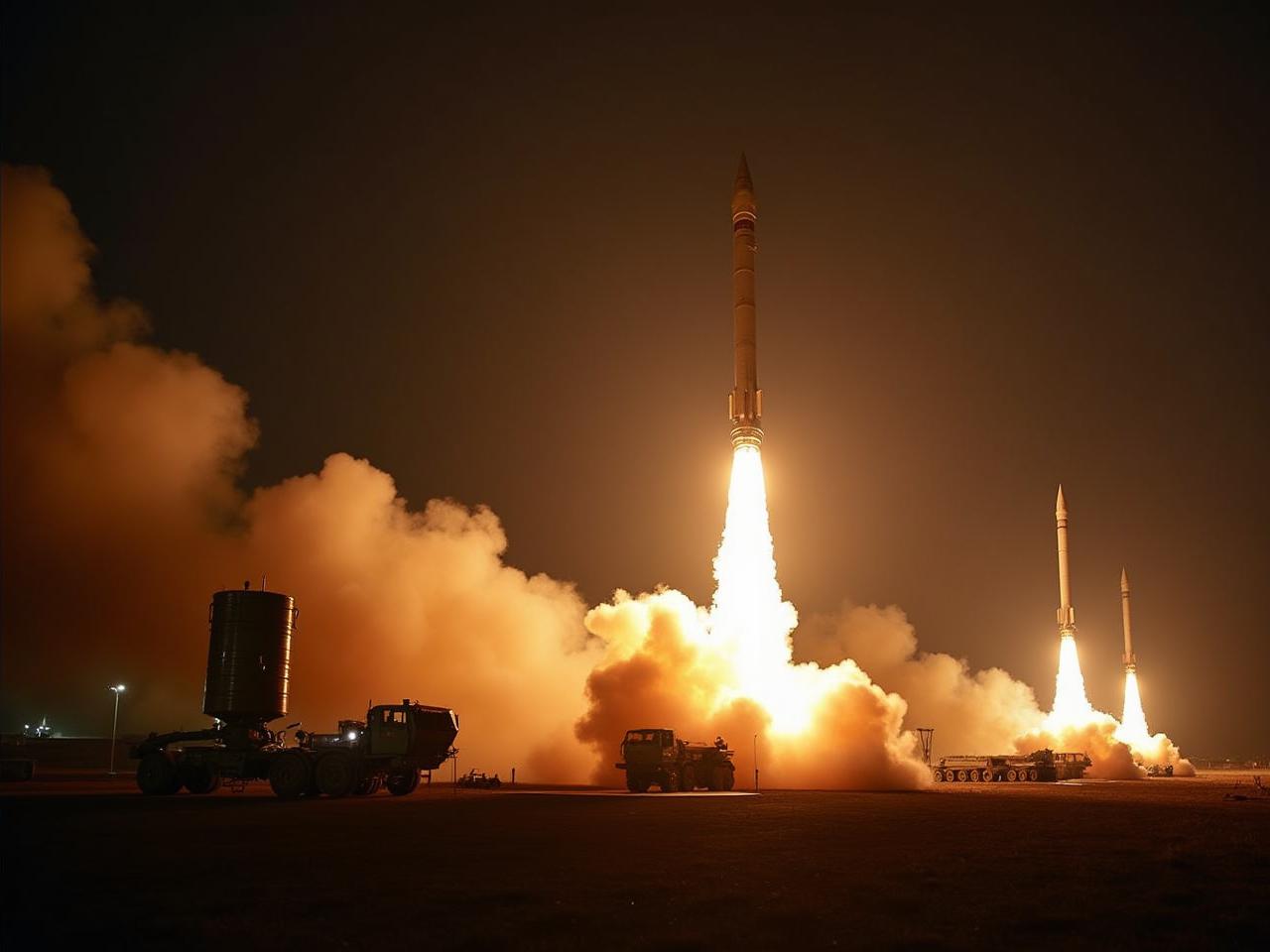Intercontinental ballistic missiles have fundamentally altered the global military balance, with their ability to deliver nuclear warheads across distances exceeding 5,500 kilometers in just minutes. These sophisticated weapons represent the pinnacle of military technology and strategic deterrence capabilities.
Russia’s RS-28 Sarmat, widely considered the strongest missile in the world, exemplifies this deadly advancement with its unprecedented 18,000-kilometer range and capacity to carry up to 15 nuclear warheads. Similarly, China’s DF-41 presents a formidable threat with its 14,000-kilometer reach, allowing it to strike anywhere in Europe or North America within 20 minutes. The United States maintains its nuclear deterrence primarily through the aging but reliable LGM-30 Minuteman III, operational since the 1970s with a 13,000-kilometer range. These deadliest missiles in the world continue to shape international relations and defense strategies.
The race for supremacy in nuclear ballistic missile technology remains intense. While Russia’s intercontinental ballistic missiles like the RS-28 Sarmat represent new developments, the U.S. maintains significant firepower with 405 Minuteman-III ICBMs deployed across three bases. Additionally, the U.S. Navy’s 14 Ohio-class submarines carry 288 Trident II missiles, each capable of delivering multiple warheads at ranges up to 12,000 kilometers. Although less discussed, India’s Agni-V, with its range of 5,000-8,000 kilometers, represents the country’s growing strategic capabilities since becoming operational in 2021.
Also Read: Top 5 Fastest Missiles in the World 2025
1. RS-28 Sarmat (Russia)
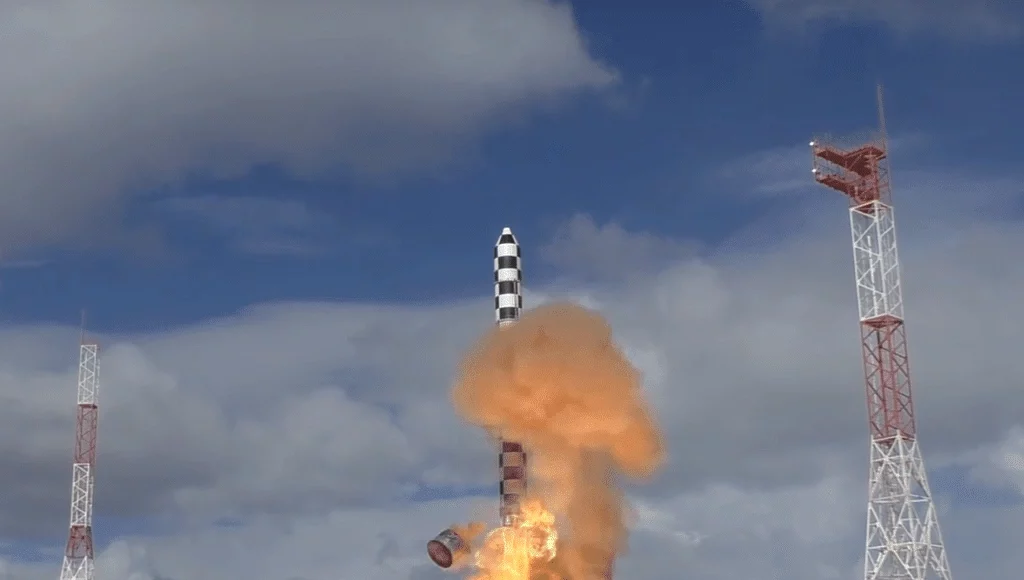
Image Source: Missile Threat – CSIS
The RS-28 Sarmat represents Russia’s next-generation nuclear deterrent, developed to replace the aging Soviet-era R-36M2 Voyevoda ICBMs. Nicknamed “Satan 2” by Western media outlets, this super-heavy intercontinental ballistic missile began development in the 2000s, with Russia awarding production contracts to Makeyev Design Bureau and NPOMash in early 2011. The missile officially entered operational service in September 2023, although its deployment has faced numerous technical challenges and testing setbacks.
RS-28 Sarmat specifications
The Sarmat is a three-stage, liquid-fueled missile with impressive dimensions and capabilities. This silo-based system stands as one of the largest intercontinental ballistic missiles currently in service.
| Specification | Details |
|---|---|
| Length | 35.3 meters |
| Diameter | 3.0 meters |
| Launch weight | 208,100 kg |
| Propulsion | Three-stage, liquid-fueled |
| Class | Heavy Intercontinental Ballistic Missile |
| NATO designation | SS-X-30 |
| Alternate name | Satan II |
| Basing | Silo-based |
Furthermore, the RS-28 Sarmat features advanced engineering elements, including an orthogrid structure in its booster casing that saves weight and improves structural strength. Its propulsion system likely uses a derivative of an existing engine, possibly related to the RD-274, with a four-nozzle configuration during first-stage propulsion as indicated by test footage. The missile also employs a “cold launch” system that ejects it from its silo using pressurized gas before the main engines ignite.
RS-28 Sarmat range and payload
The RS-28 Sarmat boasts extraordinary range capabilities that effectively allow it to strike targets anywhere on Earth. With a maximum range of 18,000 kilometers, this intercontinental ballistic missile can deliver devastating firepower to any continent. During its first publicized test launch on April 20, 2022, the missile reportedly took approximately 20 minutes to fly 6,000 kilometers to its target at the Kura range in Kamchatka.
In terms of payload capacity, the Sarmat can carry over 10 tons, making it exceptionally versatile in terms of warhead configuration. According to Russian sources, the missile can be equipped with:
- Up to 10 heavy nuclear warheads
- Up to 16 smaller warheads
- A combination of warheads and countermeasures
- Hypersonic Avangard boost-glide vehicles
The missile’s significant throw weight serves as a hedge against potential improvements in US strike capabilities and missile defenses. Moreover, this massive payload capacity represents three times as many MIRVs as Russia’s solid-fueled RS-24 Yars system.
RS-28 Sarmat deployment status
Despite claims of operational deployment, the RS-28 Sarmat has experienced a troubled development history. The missile first completed a prototype in late 2015, followed by silo ejection tests in December 2017, March 2018, and May 2018. However, the program has faced numerous delays and setbacks.
The first flight test was conducted on April 20, 2022, much later than initially planned. Russian President Vladimir Putin announced in December 2022 that the RS-28 Sarmat had been operationally deployed with the Russian Strategic Missile Forces. Subsequently, on September 1, 2023, Yuri Borisov, the head of Russian state space corporation Roscosmos, claimed the system had been put on combat duty.
Nevertheless, according to recent reports, the missile suffered what appears to be a catastrophic failure during its latest test on September 21, 2024. This follows at least one other failed flight test and two canceled tests since its initial 2022 test launch. Currently, Russia is continuing work to put the Sarmat on combat duty, though the timeline remains uncertain given these setbacks.
The missile is reportedly intended for deployment with the 13th Red Banner Rocket Division at Dombarovsky Air Base and with the 62nd Red Banner Rocket Division at Uzhur, replacing the previous R-36M ICBMs at these locations.
RS-28 Sarmat strategic impact
The RS-28 Sarmat holds significant strategic importance in Russia’s nuclear deterrence strategy. As a critical component of Russia’s nuclear triad, the missile is designed to bypass advanced missile defense systems through its speed, maneuverability, and countermeasures.
One key strategic advantage is the missile’s ability to elude anti-missile defense systems with a short initial boost phase, giving enemy surveillance systems a tiny window to track. President Putin has emphasized this feature, stating that it shortens the interval when the missile can be tracked by satellites with infrared sensors such as the U.S. Space-Based Infrared System.
Additionally, the Sarmat provides Russia with Fractional Orbital Bombardment capability that can fly a trajectory over the South Pole to targets in the United States. This unconventional approach allows it to evade missile defense systems in the northern United States. The system is also equipped with the ‘Mozyr’ active protection system, designed to negate a potential adversary’s first strike advantage.
Consequently, while Russia has a diverse nuclear arsenal, its silo-based ICBMs like the Sarmat hold particular significance due to their payload capacity and strategic positioning in the nuclear deterrence equation. Despite ongoing technical difficulties, the RS-28 represents a potentially formidable advancement in nuclear delivery systems that could influence the strategic balance between major powers for decades to come.
Also Read: 10 Best Fighter Jets in the World 2025
2. LGM-30G Minuteman III (USA)
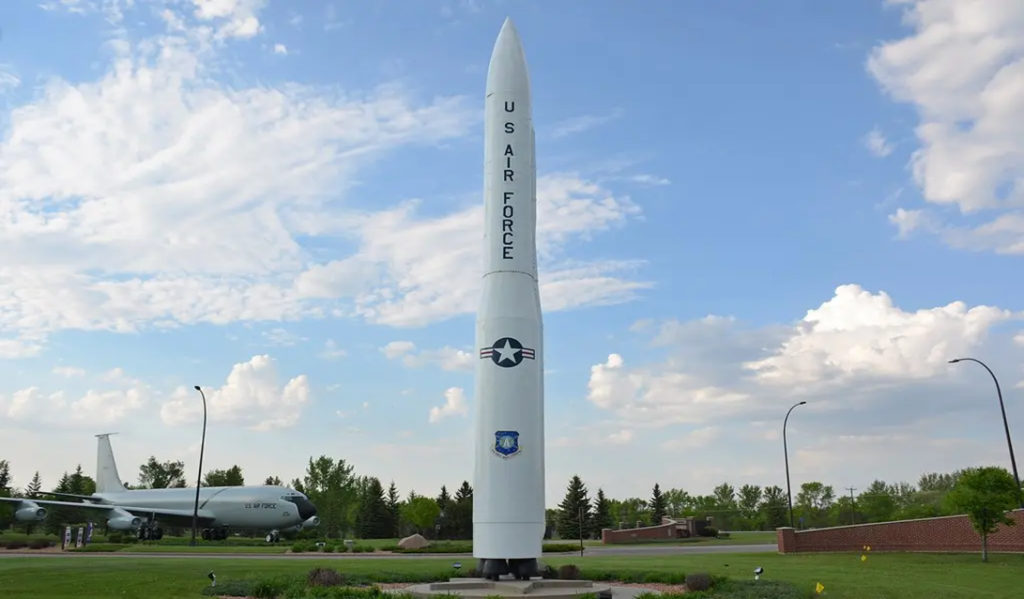
Image Source: Air Force Museum
The LGM-30G Minuteman III stands as America’s sole operational land-based intercontinental ballistic missile and serves as a cornerstone of the U.S. nuclear triad. First deployed in June 1970, this solid-fueled ICBM has undergone numerous modernization efforts yet remains fundamentally the same missile that entered service over five decades ago. Currently, the Air Force is preparing to replace these aging missiles with the LGM-35A Sentinel ICBM system, ensuring the continued viability of the land-based nuclear deterrent.
LGM-30G Minuteman III specifications
The Minuteman III features a three-stage solid-propellant design that offers reliability, reduced maintenance requirements, and rapid launch capability compared to liquid-fueled predecessors.
| Specification | Details |
|---|---|
| Length | 18.2 meters (59.9 feet) |
| Diameter | 1.67 meters (5.5 feet) |
| Launch weight | 36,030 kilograms (79,432 pounds) |
| Propulsion | Three solid-propellant rocket motors |
| First stage thrust | 203,158 pounds |
| Second stage thrust | 60,793 pounds |
| Third stage thrust | 35,086 pounds |
| Max speed | Approximately 24,000 km/h (15,000 mph) at burnout |
| Ceiling | 1,120 kilometers (700 miles) |
The missile utilizes a three-stage propulsion system with solid-fuel rockets manufactured by ATK, including a refurbished M55A1 first stage, SR-19 second stage, and SR-73 third stage. This configuration enables extremely fast acceleration, helping to reduce the likelihood of interception by enemy defense systems.
LGM-30G Minuteman III range and payload
The Minuteman III offers impressive range capabilities, allowing it to strike targets virtually anywhere in the world. Its maximum range exceeds 13,000 kilometers (8,100 miles), though official sources typically list it as “6,000-plus miles” (approximately 9,700 kilometers). This strategic reach enables the missile to strike targets across continents within minutes of launch.
Regarding payload capacity, the Minuteman III was historically the world’s first missile to carry Multiple Independently Targetable Reentry Vehicles (MIRVs). Originally equipped to carry three separate warheads, each missile has been limited to a single warhead under international treaty agreements since 2005. The current warhead options include:
- W78 warhead with yield of 335-350 kilotons
- W87 warhead with yield of 300 kilotons
The missile’s guidance system has been upgraded throughout its service life, improving its accuracy from an original Circular Error Probable (CEP) of about 200 meters to approximately 120 meters.
LGM-30G Minuteman III deployment status
As of 2025, the U.S. maintains a force of 400 operational Minuteman III missiles, distributed among three Air Force bases:
- 90th Missile Wing at F.E. Warren AFB, Wyoming
- 341st Missile Wing at Malmstrom AFB, Montana
- 91st Missile Wing at Minot AFB, North Dakota
Each missile is housed in a hardened underground silo designed to withstand nuclear attack. These silos are connected to underground Launch Control Centers (LCCs) through hardened cable systems. Launch crews consisting of two officers maintain 24/7 alert status in these centers, ready to execute launch commands if ordered.
Additionally, the system incorporates specially configured E-6B airborne launch control center aircraft that can automatically assume command of isolated missiles should ground communication be disrupted. This redundancy ensures the president’s launch orders can be executed even in worst-case scenarios.
LGM-30G Minuteman III strategic impact
The Minuteman III represents a critical element of America’s nuclear deterrence strategy. Unlike Russia’s recent RS-28 Sarmat, the Minuteman system emphasizes reliability over raw destructive power. Its key strategic advantages include:
- Nearly 100 percent testing reliability
- Fast launch capability (approximately 60 seconds from order to launch)
- Widely dispersed basing that complicates enemy targeting
- Backup airborne launch controllers that preserve retaliatory capabilities
Throughout its service life, the Minuteman III has undergone significant modernization efforts, including the Guidance Replacement Program that updated its original computer systems with radiation-resistant semiconductor RAM, improved solid rocket fuel, and enhanced electrical power systems.
The Air Force plans to replace the Minuteman III with the Ground-Based Strategic Deterrent (GBSD) system, now designated the LGM-35A Sentinel. This program successfully completed its integrated baseline review around April 2021 and is scheduled to achieve initial operational capability by 2029. Until then, the Minuteman III continues to fulfill its role as America’s land-based nuclear deterrent.
Also Read: 4 Stealthiest Fighter Jets in the World
3. DF-41 (China)
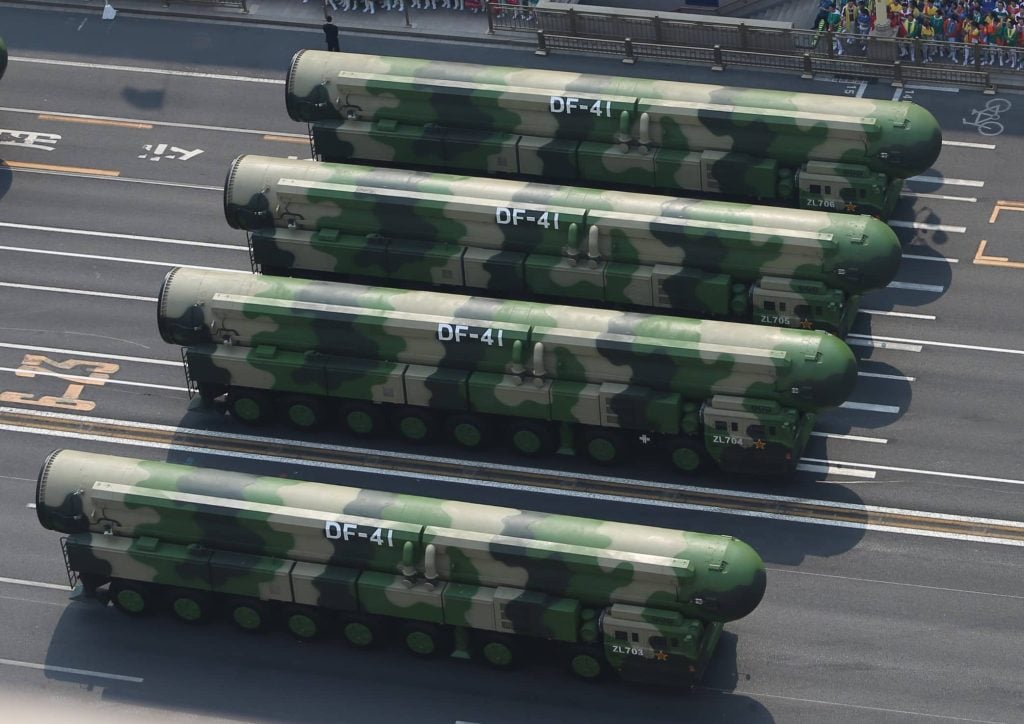
Image Source: Missile Threat – CSIS
China’s DF-41 intercontinental ballistic missile represents the most advanced strategic weapon in Beijing’s nuclear arsenal, first publicly revealed at a military parade in 2019 celebrating the 70th anniversary of the People’s Republic of China. Developed as part of the Dongfeng (“East Wind”) missile series, this fourth-generation ICBM began development in July 1986 and underwent extensive testing between 2012 and 2018, with analysts estimating six to eight flight tests prior to deployment.
DF-41 specifications
The DF-41 features an impressive set of technical specifications that place it among the most powerful intercontinental ballistic missiles currently operational:
| Specification | Details |
|---|---|
| Chinese/US designation | DF-41 / CSS-X-10 |
| Length | 20-22 meters |
| Diameter | 2.25 meters |
| Launch weight | 80,000 kg |
| Propulsion | Three-stage, solid propellant |
| Guidance system | Inertial with stellar/satellite updates |
| Accuracy (CEP) | Approximately 100 meters |
| Basing options | Road-mobile, rail-mobile, silo-based |
In contrast to many liquid-fueled missiles, the DF-41’s solid propellant design offers enhanced reliability, reduced maintenance requirements, plus faster deployment time. Furthermore, the missile’s relatively compact dimensions enable various deployment options that maximize survivability.
DF-41 range and payload
Among the most significant features of the DF-41 is its exceptional range of 12,000-15,000 kilometers, making it China’s longest-range missile. This impressive reach allows the DF-41 to target virtually anywhere in the continental United States from mainland China.
Even more remarkable is the missile’s payload capacity. With an estimated payload weight of 2,500 kg, the DF-41 can reportedly carry up to 10 multiple independently-targetable reentry vehicles (MIRVs) with nuclear warheads. Yet, most experts believe a typical warload configuration includes fewer MIRVs alongside several penetration aids designed to challenge missile defense systems.
DF-41 deployment status
After decades of development, the DF-41 likely entered limited production around 2019. At China’s 70th anniversary parade on October 1, 2019, sixteen DF-41 launchers were publicly displayed, confirming the system’s operational status.
The missile is primarily road-mobile, carried by a Tian HTF5980 special wheeled chassis with 16×16 wheel configuration. This vehicle provides substantial cross-country mobility across various terrain types, yet remains optimized for hard-surface roads. Beyond the road-mobile version, evidence indicates China has developed both rail-mobile and silo-based variants.
Currently, analysts believe China maintains at least 20 operational DF-41 missiles, possibly organized into two brigades as indicated by Chinese sources during the 2019 parade. Moreover, as of November 2022, China continues constructing additional silos specifically designed for DF-41 ICBMs.
DF-41 strategic impact
The DF-41 presents several significant strategic challenges for adversaries. Primarily, its combination of extreme range, MIRV capability, and diverse deployment options makes it extraordinarily difficult to track, target, or intercept.
The road-mobile versions offer exceptional survivability by utilizing China’s vast tunnel network, emerging only during crises to move to remote launch positions. Likewise, the rail-mobile variant creates unique tracking challenges as launchers can be disguised as passenger trains, utilize high-speed rail networks, and exploit tunnels for protection from satellite surveillance.
Recently, China has accelerated silo construction for DF-41 missiles, with U.S. intelligence identifying approximately 120 new silos in Gansu province. This expansion represents the largest growth in China’s land-based nuclear capabilities in history, fundamentally altering strategic calculations.
Beyond pure numbers, the DF-41’s technical capabilities – particularly its MIRV warheads – provide China with enhanced ability to overwhelm missile defense systems, thereby strengthening its nuclear deterrence posture vis-à-vis the United States and other nuclear powers.
4. UGM-133 Trident II (USA/UK)
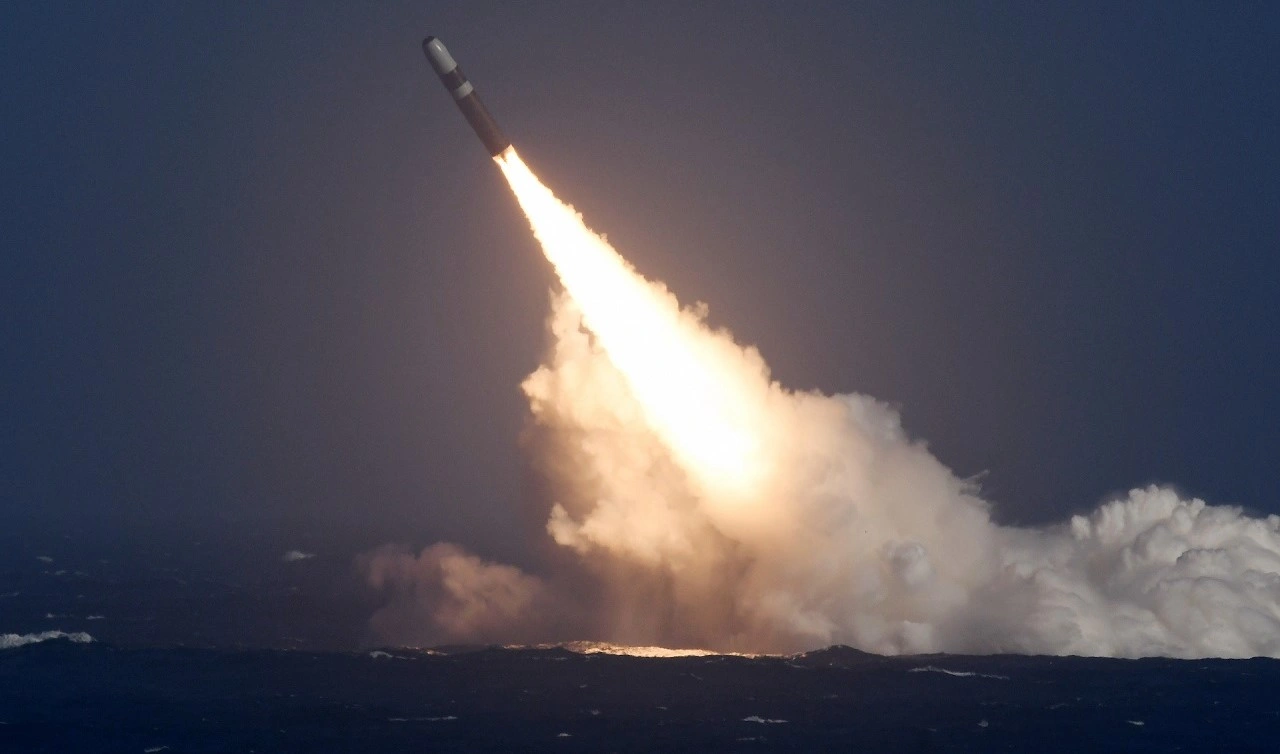
Image Source: Nuclear Companion
Deployed aboard submarines of both the United States and United Kingdom navies, the UGM-133 Trident II D5 missile serves as the backbone of the sea-based nuclear deterrent for both nations. This submarine-launched ballistic missile, initially deployed in March 1990, represents one of the most reliable and accurate submarine-launched nuclear delivery systems ever developed. As a key element of the U.S. strategic nuclear triad, the Trident II complements land-based ICBMs with mobile launch platforms that are inherently more difficult to target.
UGM-133 Trident II specifications
The Trident II D5 boasts impressive technical specifications that enable its exceptional performance capabilities:
| Specification | Details |
|---|---|
| Length | 13.42 m (44 ft 6.6 in) |
| Diameter | 2.11 m (6 ft 11 in) |
| Launch weight | 59,090 kg (130,000 lbs) |
| Propulsion | Three-stage solid propellant |
| Guidance system | Inertial with stellar reference update |
| Accuracy (CEP) | 90 meters |
| Manufacturer | Lockheed Martin Space |
| Unit cost | Approximately $37.5 million (2019) |
Notably, all three stages of the Trident II are constructed of graphite epoxy, making the missile considerably lighter than conventional designs. This weight reduction contributes to its extended range and payload capacity.
UGM-133 Trident II range and payload
The Trident II showcases extraordinary range capabilities, with maximum reach of 12,000 kilometers (7,500 miles), enabling it to strike targets virtually anywhere on Earth from patrol areas. Even with a full warhead load, the missile maintains substantial range, though this can decrease depending on payload configuration and flight profile.
Regarding payload capacity, the missile carries a Post-Boost Vehicle (PBV) that can deploy up to:
- 8 MIRV Mk-5 warheads with W88 (475 kt yield)
- 12 MIRV Mk-4/Mk-4A warheads with W76-0 (100 kt yield) or W76-1 (90 kt yield)
- Low-yield W76-2 (5-7 kt) warheads for non-strategic roles
In practice, each missile typically carries fewer warheads due to treaty limitations, with the New START treaty capping deployable warheads at eight per missile.
UGM-133 Trident II deployment status
Currently, the Trident II D5 is deployed on 14 U.S. Ohio-class submarines and 4 British Vanguard-class submarines. Each Ohio-class submarine carries 20 missiles, reduced from 24 to comply with the New START treaty, while each Vanguard-class carries 16 missiles.
The missile’s reliability has been exceptional, with 191 successful test flights since design completion in 1989. Across all testing, including both sea and land launches, the system has achieved 207 successes out of 215 total launches.
Looking ahead, both nations plan to maintain the Trident II system well into the future. The U.S. initiated the D5 Life Extension Program (D5LEP) in 2002, replacing obsolete components with commercial off-the-shelf hardware to maintain performance while controlling costs. Simultaneously, both countries are developing new submarines—the Columbia-class for the U.S. and the Dreadnought-class for the UK—designed specifically to carry Trident II missiles into the 2050s.
UGM-133 Trident II strategic impact
The Trident II represents a critical strategic asset for both the United States and United Kingdom. Indeed, its combination of accuracy, range, and survivability makes it particularly valuable as a second-strike weapon that ensures retaliatory capability even after an enemy first strike.
From a strategic perspective, the system enhances deterrence by providing a survivable sea-based capability that can engage the full spectrum of potential targets. Because submarine-launched missiles are inherently more difficult to track and target than fixed land-based systems, they increase uncertainty for potential adversaries.
Essentially, the missile’s increased payload flexibility accommodates various treaty requirements, allowing both nations to adjust their strategic posture in response to changing international conditions. This adaptability, combined with exceptional reliability, ensures that the Trident II will remain a cornerstone of Western nuclear deterrence for decades to come.
5. RS-24 Yars (Russia)
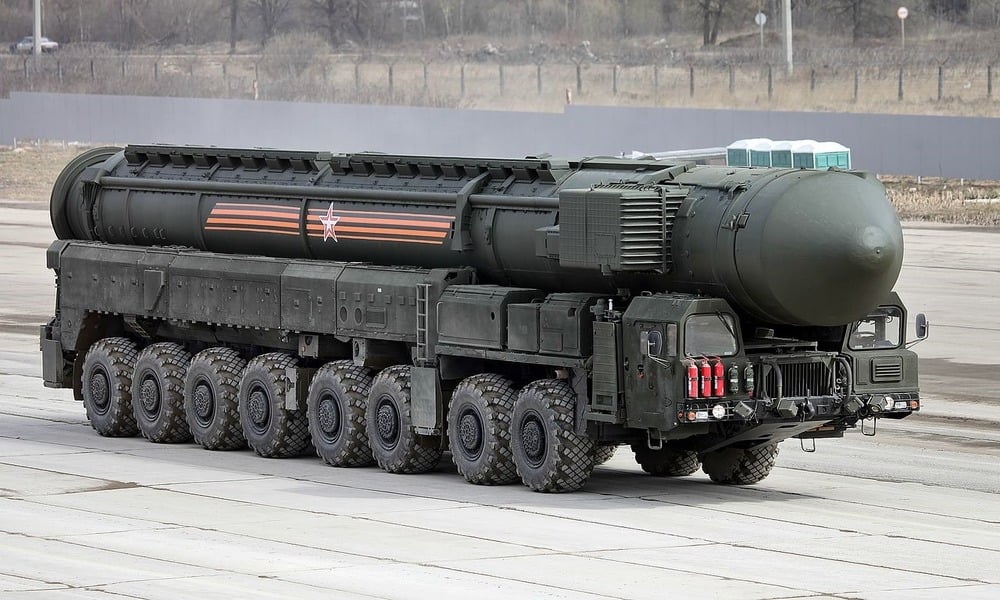
First entering service in 2010, the RS-24 Yars intercontinental ballistic missile represents a significant evolution in Russia’s nuclear arsenal, essentially serving as a MIRVed version of the older Topol-M system. This formidable weapon, designed by the Moscow Institute of Thermal Technology, can be deployed in both road-mobile and silo-based configurations, providing Russia with flexible strategic options.
RS-24 Yars specifications
The RS-24 Yars features impressive technical parameters that establish it as one of Russia’s most capable nuclear delivery systems:
| Specification | Details |
|---|---|
| Russian/NATO designation | RS-24 Yars/SS-29 or SS-27 Mod 2 |
| Length | 22.5 meters |
| Diameter | 2.0 meters |
| Launch weight | 49,600 kg |
| Propulsion | Three-stage solid-fueled |
| Guidance system | Inertial with possible GLONASS (satellite) updates |
| Accuracy (CEP) | 100-250 meters |
| Maximum speed | Mach 25 (30,600 km/h) |
| Basing options | Road-mobile, silo-based |
RS-24 Yars range and payload
The missile boasts an exceptional operational range between 10,500-12,000 kilometers, enabling it to strike targets across continents. In fact, some sources suggest a maximum reach up to 12,000 kilometers with a minimum range of 2,000 kilometers.
Regarding payload capacity, the RS-24 Yars can carry Multiple Independently targetable Reentry Vehicles (MIRVs). Different sources indicate varying capacities—from three to four warheads up to potentially ten MIRVs. Each warhead delivers a substantial nuclear yield of 150-300 kilotons.
RS-24 Yars deployment status
Currently, Russia has deployed both mobile and silo-based variants of the RS-24 Yars. As of November 2019, there were “more than 150” launchers operational, with this number likely increasing to approximately 204 missiles by the end of 2023.
The missile requires only seven minutes to prepare for launch, providing rapid response capability. At present, Russia continues to receive “around 20” Yars complexes annually, steadily modernizing its strategic forces.
RS-24 Yars strategic impact
The RS-24 Yars offers significant strategic advantages that make it among the deadliest missiles in Russia’s arsenal. Above all, its ability to maneuver during flight and deploy both active and passive decoys gives it substantial advantages against modern missile defense systems.
Additionally, the mobile variants utilize Russia’s vast network of roads, making them difficult to track and target. Together with its silo-based counterparts, the RS-24 Yars forms a vital component of Russia’s nuclear deterrence strategy—expected to remain in service for approximately 20 more years.
6. Agni-V (India)
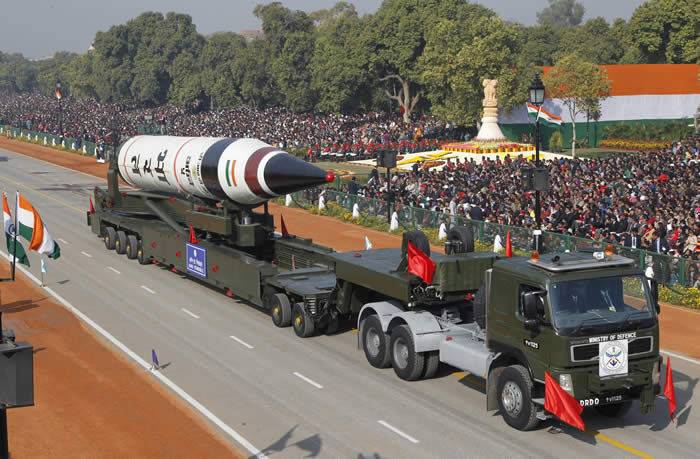
Image Source: Missile Threat – CSIS
India joined the elite club of nations possessing intercontinental ballistic missile technology with the development of Agni-V, a weapon that significantly altered the strategic equilibrium in Asia. Developed by the Defense Research and Development Organization (DRDO), this nuclear-capable missile first underwent testing in April 2012 from Abdul Kalam Island off the coast of Odisha, marking a watershed moment in India’s indigenous defense capabilities.
Agni-V specifications
The Agni-V features advanced engineering characteristics that place it among sophisticated nuclear delivery systems globally:
| Specification | Details |
|---|---|
| Length | 17.5 meters |
| Diameter | 2.0 meters |
| Launch weight | 50,000–56,000 kg |
| Propulsion | Three-stage solid-fueled |
| Guidance system | Ring Laser Gyro-based Inertial Navigation |
| Maximum speed | Estimated ~Mach 24 (approx. 29,400 km/h) |
| Basing | Road-mobile (canisterized launch) |
| Launch platform | Transporter Erector Launcher (TEL) |
As a “canisterized” missile, the Agni-V employs a sealed container design that reduces maintenance requirements yet simultaneously decreases launch preparation time. This cold-launch system ejects the missile using pressurized gas before the rocket motor ignites.
Agni-V range and payload
The Agni-V boasts impressive operational parameters suitable for strategic deterrence. Its range varies according to different sources, with official statements generally indicating 5,000-5,500 kilometers. Therefore, analysts believe the actual range extends to 7,000-8,000 kilometers[241], especially with lighter payloads.
Regarding payload capacity, the missile can carry a nuclear warhead weighing 1,500-1,650 kilograms. Notably, recent tests confirmed Multiple Independently Targetable Re-entry Vehicle (MIRV) capability through Mission Divyastra, enabling a single missile to deploy multiple warheads at different targets. Hence, this technology essentially functions as a “force multiplier” according to former DRDO Director Dr. V.K. Saraswat.
Agni-V deployment status
Following its maiden test in 2012, the Agni-V underwent several subsequent tests in 2013, 2015, 2016, and 2018. The missile transitioned from open launching to canister-based deployment in January 2015. After successful user trials, the Strategic Forces Command officially inducted the system around 2019.
Most recently, India successfully tested the MIRV-capable variant in March 2024 under codename Mission Divyastra. Defense Minister Rajnath Singh subsequently confirmed the operational deployment of this advanced variant, placing India among select nations possessing this technology.
Agni-V strategic impact
The Agni-V represents a significant strategic asset for India, primarily because its range enables coverage of the entire Chinese mainland, including eastern coastal regions. Furthermore, it provides India with credible second-strike capability against potential adversaries.
The missile’s MIRV technology adds another dimension by allowing multiple targets to be engaged simultaneously, complicating enemy defense calculations. In addition, MIRVs make the missile more difficult to intercept as they overwhelm ballistic missile defense systems through multiple warheads plus decoys.
Overall, the Agni-V serves as a cornerstone of India’s nuclear deterrence posture, especially considering reported plans for an even more capable Agni-VI with range exceeding 10,000 kilometers that would extend India’s reach across Europe, Asia, Africa, Oceania, and parts of North America.
7. Hwasong-17 (North Korea)
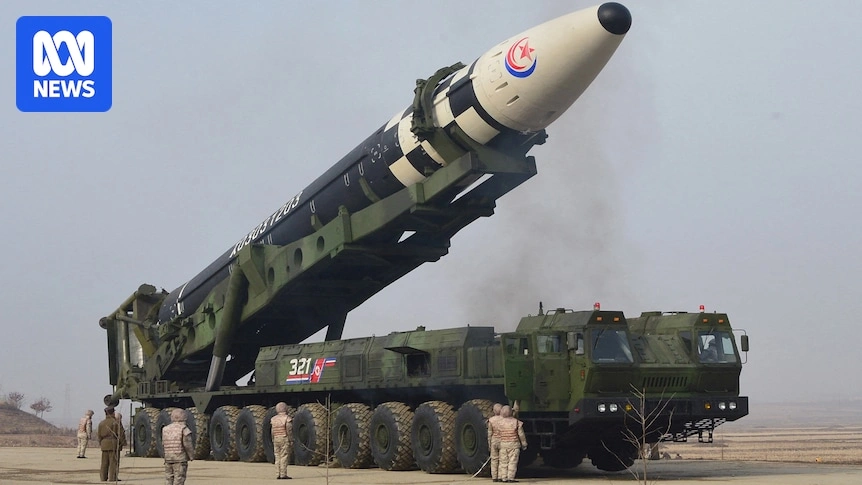
Image Source: ABC News
North Korea hails the Hwasong-17 as their most powerful nuclear weapon system, describing it as the “world’s strongest strategic weapon”. Unveiled at a military parade in October 2020, this massive intercontinental ballistic missile represents a significant advancement in Pyongyang’s nuclear delivery capabilities, attracting international concern for its potential to strike targets throughout the continental United States.
Hwasong-17 specifications
The Hwasong-17 stands out as the largest road-mobile, liquid-fuelled ICBM currently in existence. Its intimidating dimensions and technical parameters establish it as North Korea’s premier strategic weapon:
| Specification | Details |
|---|---|
| Length | 24-26 meters |
| Diameter | 2.4-2.5 meters |
| Mass (fueled) | 80,000-110,000 kg |
| Propulsion | Two-stage, liquid-fueled |
| Launch platform | 11-axle Transporter Erector Launcher (TEL) vehicle |
| Guidance system | Inertial |
| Warhead type | Likely multiple reentry vehicles (MIRVs) – nuclear capable |
Hwasong-17 range and payload
The Hwasong-17 possesses extraordinary range capabilities, estimated at 15,000 kilometers according to Japanese Defense Minister Yasukazu Hamada. This range effectively places the entire continental United States within striking distance. During testing, the missile demonstrated impressive flight parameters, reaching altitudes of approximately 6,000 kilometers while traveling about 1,000 kilometers horizontally.
Regarding payload capacity, analysts believe the system can deliver a substantial warhead weighing between 2,000-3,500 kg. Furthermore, the missile’s large diameter suggests it may eventually carry multiple independently targetable reentry vehicles (MIRVs), potentially 3-4 warheads depending on size.
Hwasong-17 deployment status
Following its public reveal in 2020, North Korea conducted multiple test launches of the Hwasong-17. The first successful test occurred on March 24, 2022, although South Korean intelligence disputed this claim. Nevertheless, confirmed tests took place on November 18, 2022, and March 16, 2023.
Currently, North Korea maintains at least 11 Hwasong-17 missiles. These weapons represent the pinnacle of North Korea’s estimated 55 nuclear warheads produced from approximately 70kg of enriched nuclear material.
Hwasong-17 strategic impact
The Hwasong-17 profoundly alters strategic calculations between North Korea and potential adversaries. North Korean leader Kim Jong Un described it as demonstrating “North Korea’s resolve and ability to eventually build the world’s strongest army”. Besides the psychological impact, the missile’s technical capabilities present practical challenges for missile defense systems.
Most concerning, its potential MIRV capability could overwhelm existing defense systems by deploying multiple warheads plus decoys from a single missile. At this point, even launching just a few missiles would be sufficient to penetrate United States defensive measures.
Comparison Table
Comparison of World’s Deadliest ICBMs (2025)
| Missile Name | Country | Length (m) | Diameter (m) | Launch Weight (kg) | Range (km) | Propulsion Type | Warhead Capacity | Current Deployment |
|---|---|---|---|---|---|---|---|---|
| RS-28 Sarmat | Russia | 35.3 | 3.0 | 208,100 | 18,000 | Three-stage liquid | Up to 15 warheads | Limited operational deployment |
| LGM-30G Minuteman III | USA | 18.2 | 1.67 | 36,030 | 13,000 | Three-stage solid | Single warhead (post-2005) | 400 operational missiles |
| DF-41 | China | 20-22 | 2.25 | 80,000 | 12,000-15,000 | Three-stage solid | Up to 10 MIRVs | At least 20 operational |
| UGM-133 Trident II | USA/UK | 13.42 | 2.11 | 59,090 | 12,000 | Three-stage solid | Up to 8-12 MIRVs | 14 US + 4 UK submarines |
| RS-24 Yars | Russia | 22.5 | 2.0 | 49,600 | 10,500-12,000 | Three-stage solid | 3-10 MIRVs | ~204 missiles |
| Agni-V | India | 17.5 | 2.0 | 50,000-56,000 | 5,000-8,000 | Three-stage solid | MIRV capable | Operational |
| Hwasong-17 | North Korea | 24-26 | 2.4-2.5 | 80,000-110,000 | 15,000 | Two-stage liquid | 2,000-3,500 kg payload | At least 11 missiles |
Conclusion
The evolution of intercontinental ballistic missile technology has fundamentally altered global military dynamics. These seven systems represent the pinnacle of strategic deterrence capabilities across major nuclear powers. Russia’s RS-28 Sarmat undoubtedly stands as the most physically imposing system with its 35.3-meter length and incredible 18,000-kilometer range, though deployment challenges have limited its operational effectiveness. Meanwhile, the United States maintains strategic stability through its aging but exceptionally reliable Minuteman III system alongside the submarine-launched Trident II missiles, essentially creating a two-pronged approach to nuclear deterrence.
China’s DF-41 deserves special attention for its flexibility in deployment options and significant MIRV capabilities. This system consequently provides Beijing with unprecedented strategic reach, particularly against American assets. Furthermore, though less discussed internationally, India’s Agni-V represents a significant regional power shift with its MIRV capability and extended range. Russia’s RS-24 Yars offers similar capabilities through a more mature, field-tested platform that forms the backbone of their land-based nuclear forces.
North Korea’s Hwasong-17, though technologically less sophisticated than western counterparts, nevertheless represents a significant strategic challenge given its 15,000-kilometer range that theoretically places the entire continental United States within striking distance. The missile’s massive dimensions and payload capacity make it particularly concerning despite uncertainty about its reliability and accuracy.
These advanced weapons systems thus continue to shape international relations through their mere existence rather than actual use. Their primary purpose remains deterrence—preventing conflict by ensuring that any nuclear attack would face devastating retaliation. Therefore, understanding these systems provides crucial insight into current geopolitical dynamics and the strategic calculations made by world powers. As missile defense technologies evolve alongside offensive capabilities, the balance between these deadly systems will ultimately determine global strategic stability for decades to come.
FAQs
Q1. What is currently considered the most powerful ICBM in the world?
The RS-28 Sarmat, developed by Russia, is widely regarded as the most powerful ICBM. It has an unprecedented range of 18,000 kilometers, can carry up to 15 nuclear warheads, and travels at hypersonic speeds, making it extremely difficult to intercept.
Q2. How does India’s Agni-V missile compare to other global ICBMs?
The Agni-V is India’s most advanced ICBM, with a range of 5,000-8,000 kilometers. While not as long-ranged as some other ICBMs, it is MIRV-capable and provides India with the ability to strike targets across most of Asia, significantly altering regional strategic balance.
Q3. Which country currently possesses the largest number of ICBMs?
As of 2025, Russia maintains the largest ICBM arsenal, with an estimated 306 strategic missiles capable of carrying up to 1,185 nuclear warheads. This gives Russia significant strategic deterrence capabilities on the global stage.
Q4. What makes the DF-41 ICBM particularly significant for China’s military capabilities?
The DF-41 is China’s most advanced ICBM, featuring a range of 12,000-15,000 kilometers and the ability to carry up to 10 MIRVs. Its diverse deployment options, including road-mobile, rail-mobile, and silo-based variants, enhance its survivability and strategic flexibility.
Q5. How has North Korea’s development of the Hwasong-17 ICBM impacted global security concerns?
The Hwasong-17, North Korea’s largest ICBM, has raised significant international concerns due to its estimated 15,000-kilometer range, potentially allowing it to strike targets throughout the continental United States. Its large payload capacity and potential for future MIRV capability present new challenges for missile defence systems.

